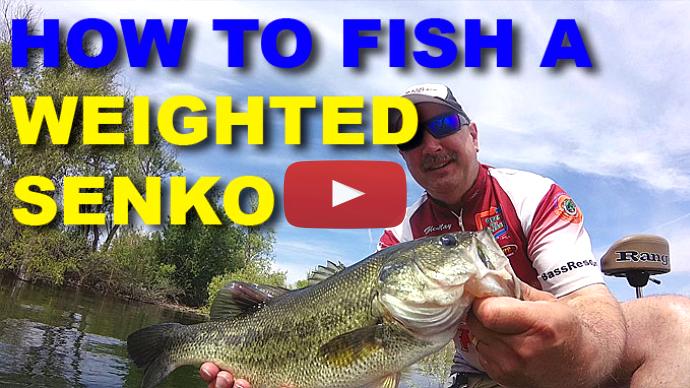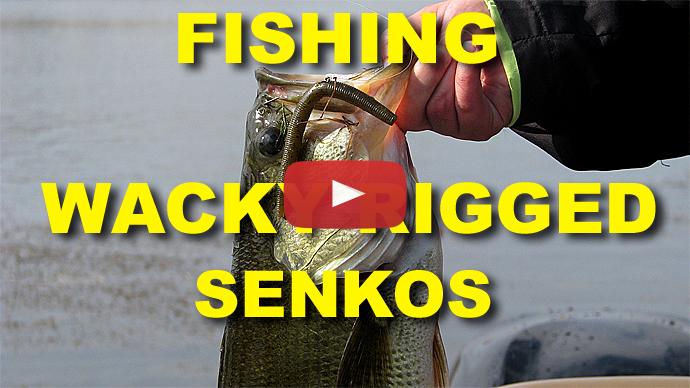I'm fishing this lake here in the middle summer real clear water reservoir. Looks like the little fish are only ones that want to come out and play, but that's okay because I'm just out here having fun jackin' fish. You can get over hundred fishing one day doing this. Just a little guy but I promise you this rig does catch big fish too. So today I'm gonna show you how to rig this up, what equipment I'm using, and then I'm gonna take you on the water and I'm gonna show you how to fish the drop shot Senko. Catch a lot of fish and big ones too.
Hey, folks. Glenn May here with BassResource.com. Today I want to talk to you about drop shotting a Senko. Yeah, it's a great way to fish a Senko, and if you're not sure how to rig this up, I've got a video on rigging Senkos. It's linked on the bottom underneath this video here. You can check that out in a little bit. Right now I want to talk to you about the equipment and the gear to use for it, and then we're going to go out and show you how to fish it.
So first off, I've got my drop shot weight here, and above it, about 18 inches above it, that's where I've got my spin shot hook nose hooked to my Senko. Now, you can wacky rig this too. If you want to wacky rig it, go for it. I just have it nose hooked for this purposes, but wacky rigging is perfect also. The reason I have the distance here, 18 inches, in the summer months and when you fish in clear water, you want a longer leader. You want this bait further up off the bottom. This fish will see it from further distances. They're willing to come after it from further distances. You're going to attract more fish that way. And in clear water, I want them focusing on this bait, not the weight, okay? So an 18 inch leader, 24 inch leader's perfect for these conditions. In the Winter time or in really dingy water, you can shorten it up and maybe go to 10, 12 inches, but really nothing any shorter than that. And one of the reasons why is when you cast it out, you're not fishing it vertical, straight up and down like this. You're fishing it at an angle. So even though this is 18 inches, really you're only getting it about 12 inches off the bottom, maybe 10 inches. And if you've got this way up by the hook here, you have the hook way close to the weight, well, if you're bringing it back, you're only getting maybe two inches off the bottom, maybe if that. Well, that kind of defeats the purpose of a drop shot. So I don't go any shorter than eight inches on my leader, and that's in the winter time. Right now we're using this 18 inch set-up.
Now, because we're using light line and a real light wire hook, that's a 1/0 real thin wire hook, we want to match that with a rod for this purpose. And this is a medium light action rod, nothing heavier than that. You don't want to use a medium heavy or anything like that because if you do, you risk breaking the line or straightening out that hook when you set the hook or fight the fish back to the boat.
So, that's the set-up that we're going to use today. I'm using a seven-foot rod, great, all-purpose length rod you want to use for this set-up. All right, so there's your gear. Now let's go out and fish it.
All right, so with the drop shot rig, the first thing you want to do is when you cast it out there, just cast a nice soft, easy lob cast. You've got a medium light action rod. It's going to throw it out there for you. You don't need to throw it really hard, and a matter of fact, if you throw it really hard, the weight can wrap around the bait, and then it's going to get all tangled and mess up your presentation anyway. So just throw it nice and easy, or you can actually do a pitch cast. That works too.
Now once you get it out there, as it's falling, let it fall in slack line, watch that line where it enters the water. Be real ... pay close attention to that because sometimes the bite occurs when the bait is falling. And so you need to watch that line for any movement. Watch for a pop, twitch, anything that appears as though something is on the other line playing with it. If that happens, reel up the slack, set the hook. And that reminds me, when you set the hook, you don't need to yard on it, don't yank on it really, really hard. Instead what you want to do is just pull back nice and easy. The hook set isn't that hard. It's just kind of a huh, and that's about it. You don't need to yard really hard. As a matter of fact, if you give it a real hard hook set, you're liable to break the line or straighten the hook out because again, we're using a real light wire hook and six pound test. Doesn't take a whole lot of energy to get that little light wire hook to penetrate past the barb. So it's just a real light hook set.
So let me get this ... looks like my line tangled up just a little bit on this, and we'll cast it out there. I'll show you how to ... what we're going to do on the presentation.
All right. So, I'm just going to do a pitch cast here because I'm going go real short cast here. Throw it out there. Let it fall. I'm watching it fall, watching it fall. I got the ... I flip the reel handle down or the bail just in case a fish bites. All right, now it's on the bottom, and I know it's on the bottom because the line just went slack on me.
Now the next thing I'm going to do is just reel up to it and hold it tight, just hold a little pressure on it. You're actually going to reel down a little bit and get the rod ready to ... the hook set position. And just hold it and not do anything. Now that may seem like the baits just sitting there all by itself not doing anything, but trust me, it is moving around. I'll tell you why. If you take your hand, hold it in front of you for 30 seconds. Try to hold it as still as you possibly can. I bet you can't. Okay, there's going to be a little slight movement here and there. You're not a manikin, so you're not going to hold it absolutely still. Well, that movement is going to transmit itself down the rod and down the line to your bait. Not only that, but the water actually has current in it. Even if it's in a lake, it still has current in it be it wind-driven current, wave-driven current, something like that, it's moving the bait as well. And if you have a little bit of a breeze on the water, then that slight chop on the water, well, it's lapping up against your line. That's going to transmit to the bait as well. So it's always moving, even if you're not doing anything.
So just hold it steady and wait. A lot of times a fish will come up and bite it, just when you're doing this. Now obviously this isn't a fast technique. It's one that requires a lot of patience. You're not going to cover a whole lot of water. You're just going to ... This is what you do when you find an area that's got a lot of fish in it, and you want to go through it, pick it apart piece by piece and get every bite you can. That's what this technique is for. If you want to go through and catch a lot of fish really fast and cover a big area, this isn't the technique to use. This requires your patience.
All right, so now we've held this for a little while. The next thing you'll want to do is you can just move the bait a little bit with just your rod tip, just a little pop, pop, pop, pop, pop, pop, pop, real subtle, real subtle, and that's it. And hold it steady again. Now remember, you're moving the bait, not the weight. So it's real, real subtle, just slack line twitching. You don't want to move that weight at all, just move the bait. Pop, pop, pop, pop, pop, pop, pop, just little taps, get it to dance a little bit, then hold it still and wait for that bite.
Finally when it gets to the point where you can't stand it anymore, 30 seconds longer. There's not set time. It's all up to your patience. Just lift it back up, let it drop right back down, reel up the slack, and you're back at it again, same thing again, real slow, methodical, patient approach, pop, pop, pop, pop, pop, pop, pop. Some people like to scoot it on the bottom. You reel it down, and you pop, pop, pop, pop while lifting up on the rod tip, so you move the bait along a little bit. That's one way to do it, but I like to just let it sit there and just pop, pop, pop, pop, pop. That's all there is to it.
Now I'll fish it a little bit differently during different times of the year. So for example, in the summer ... or different places. In the summer and in the winter time, that's when most of the fish are out in the main lake, out in a little bit deeper water. So during those times of the year, I'm going to fish main lake points, underwater humps, rock piles, creek beds, ledges, where the creek channel swings in close to the shoreline. Those are the type of things I'll be fishing during those time of the year. In the spring and in the fall, then the fish, most of them are up shallow, feeding heavily. So during that time of the year, I'm going to be fishing the back of coves, back of creek channels, secondary points, big flats, weedy flats, those type of things. That's what I'm going to be targeting using this technique as soon as I locate them. If you do that during those times of year, fish it this way, you're going to have a lot of fun, catch a lot of fish.
For more tips and tricks like this, visit bassresource.com.



